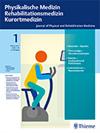The Effects of the Hybrid Telerehabilitation Exercise Program in Inactive University Students during COVID-19 Pandemic – A Randomized Controlled Study
IF 0.5
4区 医学
Q4 REHABILITATION
Physikalische Medizin Rehabilitationsmedizin Kurortmedizin
Pub Date : 2021-11-12
DOI:10.1055/a-1867-4976
引用次数: 0
Abstract
Abstract Background/Aim The need for alternative methods to prevent physical inactivity and related problems is increasing day by day due to the prevalence of physical inactivity among university students, especially in the pandemic. This study aimed to investigate the effects of a hybrid telerehabilitation exercise program on the physical inactivity, poor sleep quality and physio-mental negativities caused by the pandemic in university students. Materials and Methods The study was completed with sixty-three physically inactive students with poor sleep quality, divided into two groups. The physiotherapist made all assessments at baseline and after the 6-week for both groups. Assessments consisted of Pittsburgh Sleep Quality Index (PSQI), Beck Depression Inventory (BDI), Short Form-12 (SF-12), and International Physical Activity Questionnaire-Short Form (IPAQ-SF). While no exercise program was applied to the control group, one session synchronous exercise training and one session control education were given to the exercise group. After two synchronous training sessions, the exercise group asynchronously continued the exercise program including indoor walking, flexibility and strengthening exercises for 6 weeks. Results According to inter-groups analysis, PSQI (p=0.026), BDI (p=0.037), SF-12 Mental (p=0.007), and IPAQ-sitting (p=0.003) of the exercise group had significant differences compared to the control. Also, the exercise group's PSQI, BDI, SF-12, and IPAQ-sitting time were p<0.001, while no change was observed in the control group in the within-group analysis (p>0.05). Conclusion Hybrid telerehabilitation exercise programs are a valuable, simple, and practical tool to improve sleep quality, prevent inactivity, develop and protect mental health among university students. Encouraging physically inactive people to engage in such methods may be one of the primary preventive approach to prevent the future negative consequences.COVID-19大流行期间非运动大学生混合远程康复训练计划的效果——一项随机对照研究
背景/目的由于大学生普遍缺乏身体活动,特别是在疫情期间,对预防缺乏身体活动及相关问题的替代方法的需求日益增加。本研究旨在探讨混合远程康复训练方案对大学生因新冠肺炎引起的缺乏运动、睡眠质量差和身心负性的影响。材料与方法研究人员将63名缺乏运动且睡眠质量差的学生分为两组。物理治疗师在基线和6周后对两组进行所有评估。评估包括匹兹堡睡眠质量指数(PSQI)、贝克抑郁量表(BDI)、短表12 (SF-12)和国际体育活动问卷短表(IPAQ-SF)。对照组不进行任何运动计划,运动组进行1次同步运动训练和1次控制教育。在两次同步训练后,运动组继续进行包括室内步行、柔韧性和强化训练在内的运动项目,持续6周。结果经组间分析,运动组的PSQI (p=0.026)、BDI (p=0.037)、SF-12 Mental (p=0.007)、IPAQ-sitting (p=0.003)与对照组比较差异均有统计学意义。运动组PSQI、BDI、SF-12、ipaq -久坐时间差异均为p0.05)。结论混合远程康复训练是改善大学生睡眠质量、预防缺乏运动、发展和保护心理健康的一种有价值、简便、实用的工具。鼓励缺乏运动的人采用这些方法可能是预防未来负面后果的主要预防措施之一。
本文章由计算机程序翻译,如有差异,请以英文原文为准。
求助全文
约1分钟内获得全文
求助全文
来源期刊
CiteScore
1.10
自引率
25.00%
发文量
70
审稿时长
3 months
期刊介绍:
The Journal of Physical and Rehabilitation Medicine offers you the most up-to-date information about physical medicine in clinic and practice, as well as interdisciplinary information about rehabilitation medicine and spa medicine.
Publishing 6 issues a year, the journal includes selected original research articles and reviews as well as guidelines and summaries of the latest research findings. The journal also publishes society news and editorial material. “Online first” publication ensures rapid dissemination of knowledge.

 求助内容:
求助内容: 应助结果提醒方式:
应助结果提醒方式:


